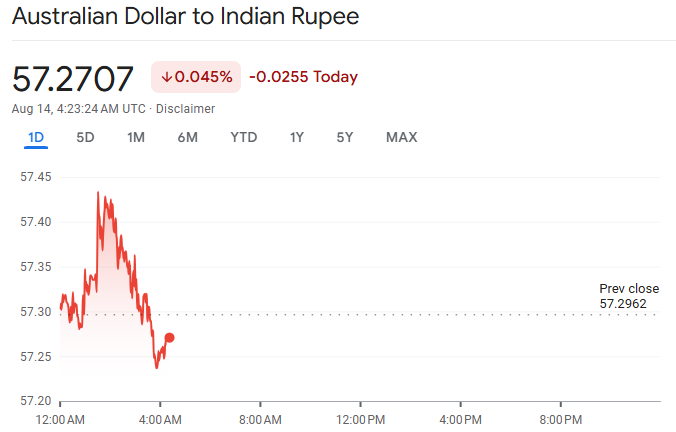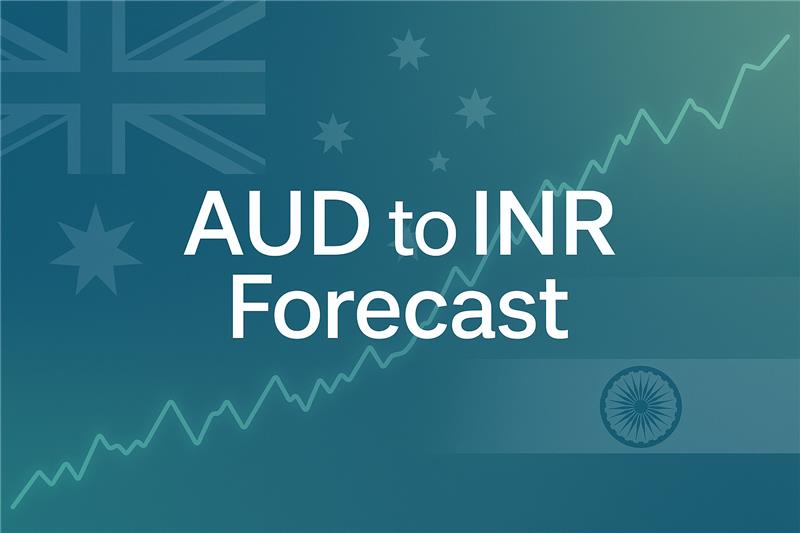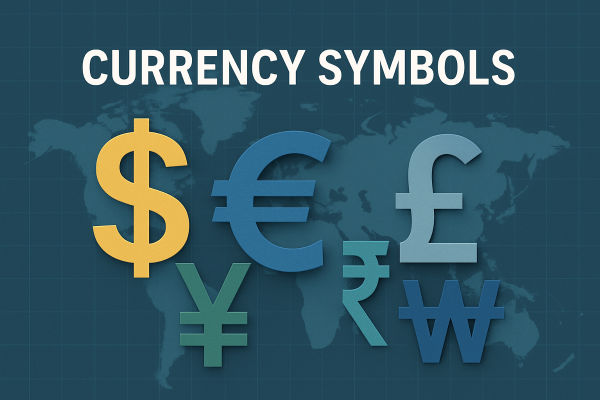As of today, the Australian dollar trades near ₹57.2–₹57.4 per AUD in the interbank market, with indicators quoting an intraday range around ₹57.10–₹57.47 and a 52-week range of ₹50.68–₹58.15.
The latest catalysts are a 25 bps RBA rate cut to 3.60% (12 Aug 2025), the RBI holding its repo at 5.50%, and surprisingly soft inflation in both economies as Australia's annual CPI eased to 2.1% in the June quarter, while India's CPI cooled to ~1.6% in July, the lowest in years.
In the short term, the Australian Dollar Rate in India will likely pivot based on yield differences, sentiment regarding China/commodities, and overall global risk appetite.
Australian Dollar Rate in India Today (August 2025)

Market-standard sources place the AUD/INR exchange rate around ₹57.2–₹57.4. The page also shows the latest trade near ₹57.27, with bids/offers clustered a few paisa around that level during active hours.
Retail converters and remittance providers will quote slightly different rates that include fees/spreads; for example, consumer converters often show rates of 57.3–58.7 on the same day, depending on the payment method and margins.
Ranges to know right now:
Thus, when converting larger amounts (investments), try to place orders during overlapping liquidity periods (from early European to early U.S. session) when AUD crosses usually experience improved depth.
The Macro Setup Driving AUD/INR

1) Interest Rate Gap: RBI Holds, RBA Trims
On 12 Aug 2025, the Reserve Bank of Australia (RBA) lowered its cash rate by 25 basis points to 3.60%, attributing the decision to a decrease in inflation. Australia's CPI is now close to target: headline 2.1% YoY for the June quarter and trimmed mean 2.7%, the lowest core read since late 2021. Lower policy rates usually reduce a currency's carry appeal, all else equal.
By contrast, the Reserve Bank of India (RBI) has kept the repo at 5.50%. Markets expect patience from the MPC, and several desks argue that near-term cuts are unlikely if inflation edges up again later in the year, even after India's July CPI dropped to ~1.55%, an eight-year low.
The broader difference in policy rates favours the Rupee over the Australian Dollar, posing a slight challenge for AUD/INR, but not if risk appetite or commodities turn distinctly in favour of AUD.
2) Inflation Trajectories
Australia's inflation progress is clean: both the quarterly CPI and the monthly indicator confirm a glide toward the target band.
India's prints declined significantly due to a drop in food prices and base effects; economists warn that the extremely low figures may revert to higher levels later in FY26, limiting the RBI's ability to ease swiftly.
If India's inflation stays subdued while Australia's eases further, the real-rate differential may continue to favour INR.
3) China and Commodities: AUD's External Lever
The Aussie dollar is a classic commodity/risk-on proxy, with a strong beta to iron ore and China's growth pulse. Recent strategy revisions emphasise stable iron ore amidst policy/tariff disruptions and uncertainty in China.
Should Chinese stimulus significantly boost materials demand, AUD could outperform cyclically, even against high-yield currencies like INR Conversely, a China wobble or weaker commodities would weigh on AUD.
4) Risk Appetite and USD Path
AUD also appreciates in risk-on markets and declines when the USD gains strength due to global risk aversion. For AUD/INR specifically, a strong USD can pressure both AUD and INR; the cross then hinges on which currency falls faster against the USD.
If India stays stable and the RBI manages volatility, INR could be somewhat resilient during general USD increases, limiting AUD/INR surges.
AUD to INR Short-Term Outlook
Monetary policy signalling: Any RBA indication suggesting additional easing risk or an extended pause will impact AUD. On the Indian side, RBI messages regarding growth versus inflation priorities, along with liquidity operations, will influence INR's carry profile.
Recent commentary from economists and bank research suggests the RBI may stay on hold in the near term while monitoring food prices after the July collapse. That stance supports INR.
Data Calendar:
Australia: Monthly CPI indicator, labour market prints, China-linked data via trade volumes.
India: CPI food trajectory, growth data, balance-of-payments signals, RBI FX operations (implied via market behaviour).
Commodities Tape: Iron ore stability is constructive for AUD, but meaningful upside usually needs China's growth momentum. Keep an eye on Australian government export projections that already assume lower iron ore values into 2026–27; this tempers long-run AUD optimism unless offset by other drivers.
Where Could AUD/INR Trade This Year?

Predictions differ as consumer-oriented platforms generally release month-ahead ranges near the current spot, usually between ₹56 and ₹59 for short-term fluctuations.
For example, retail platforms show a daily band around ₹57 with a high-low range within that extensive area; long-term web predictions display broad cones due to fluctuations.
Consider these results as general indicators rather than trading signals. Macro fundamentals (policy gap, commodities, Chinese growth) continue to be the main drivers.
A practical way to think about scenarios:
Bearish case (back to mid-₹55s/₹56): China disappoints, commodities soften, RBA signals a cut cycle or weaker growth, RBI stays firm, and India's external balances remain comfortable.
A Sensible 2025 Playbook for AUD to INR Traders
1) Track the Policy Spread: If RBI stays put and RBA eases further, AUD/INR rallies may stall near resistance unless China/commodities offset. On the other hand, if inflation in India rises again and the RBI signals a possible easing while the RBA holds steady, the momentum may shift in favour of the AUD.
2) Watch China-linked Headlines: Infrastructure stimulus, housing stabilisation, or credit growth in China often propels AUD. Weak Chinese data typically impacts AUD and, by extension, AUD/INR.
3) Use Limit Orders and Staggered Conversions: This represents the simplest advantage for retail traders. Evaluate quotes against interbank benchmarks prior to making a decision.
4) Hedge Business Exposure With Simple Forwards: Lock margins for known receivables/payables. Combine with natural hedges when possible.
5) Keep Perspective on Ranges: The 52-week span (₹50.68–₹58.15) is wide enough that chasing every tick is counterproductive. Frame decisions within macro regimes rather than headlines alone.
Conclusion
In conclusion, today's AUD/INR is in the ₹57 band, with narrow intraday swings and a well-defined 52-week corridor that reflects the past year's risk and exchange rate cycle.
For traders and investors, success in this market isn't about predicting the next 50 paisa; it's about processing by watching the policy spread, monitoring China's tape and iron ore, benchmarking every quote to the interbank rate, and hedging or staggering when the amounts matter.
Disclaimer: This material is for general information purposes only and is not intended as (and should not be considered to be) financial, investment or other advice on which reliance should be placed. No opinion given in the material constitutes a recommendation by EBC or the author that any particular investment, security, transaction or investment strategy is suitable for any specific person.





























